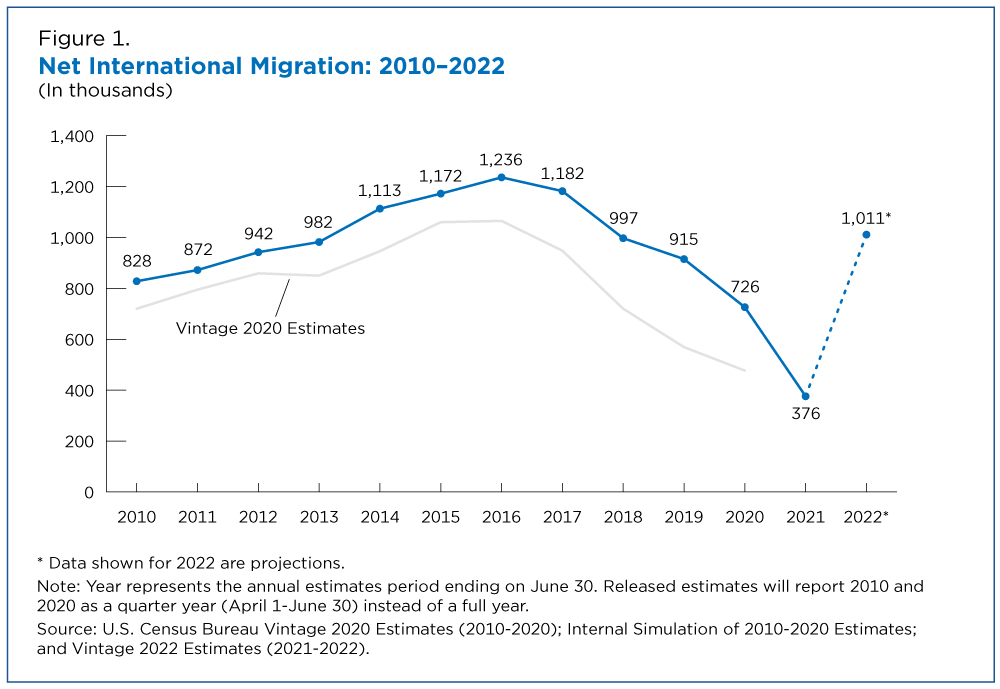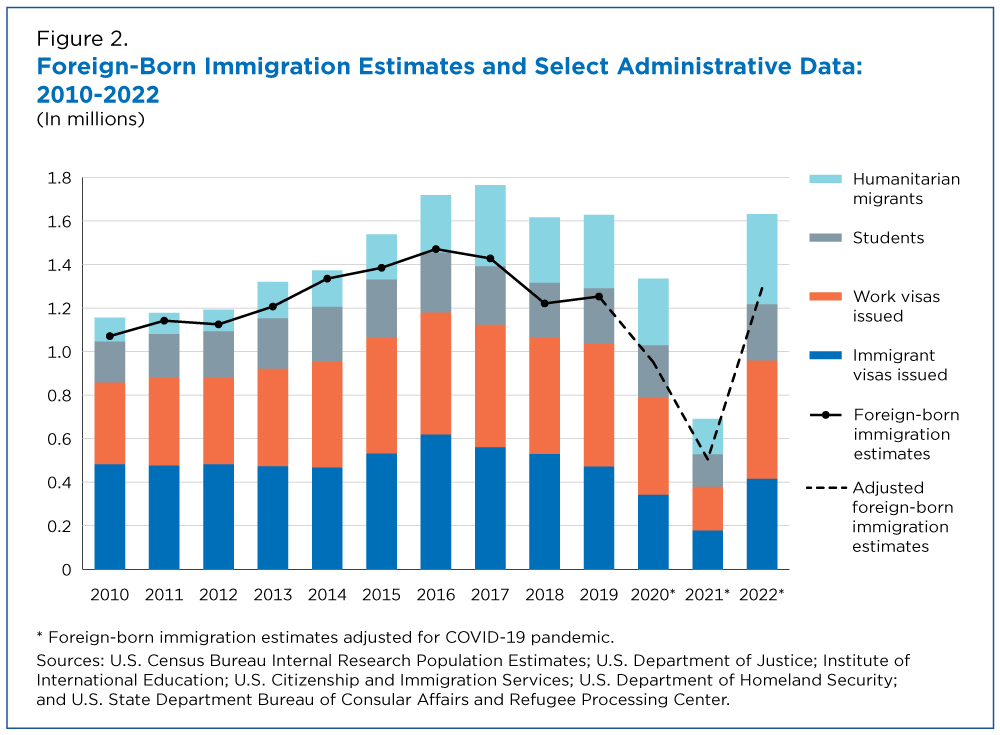Net Migration Between the United States and Abroad in 2022 Reaches Highest Level Since 2017
The U.S. Census Bureau projects that net international migration to the United States will fully rebound in 2022 from its COVID-19 slump when it experienced some of its lowest levels in decades.
According to Vintage 2022 population estimates released today, net international migration added more than a million people to the U.S. population between July 1, 2021 and July 1, 2022.
This is the first time net international migration increased since 2016, marking the largest single-year increase since 2010 — an indication that net migration flows to the United States are on track to return to pre-pandemic levels this year.
Travel restrictions to the United States were relaxed towards the end of 2021, coinciding with substantial gains in international migration in 2022.
International migration has been low since 2020, the first year of the pandemic, due to global disruptions such as travel restrictions and closed borders in addition to a tremendous backlog in processing visas and refugee resettlements.
The pandemic prompted the Census Bureau to take additional steps and adjust the estimates to reflect major shifts in international migration during that period.
Population estimates traditionally use migration data from the American Community Survey (ACS) to measure annual international migration levels. Since survey data lag one year behind, the Census Bureau used more current federal statistics on visa issuances, new international student enrollments, refugees and asylum-seekers for the current year’s estimate.
Travel restrictions to the United States were relaxed towards the end of 2021, coinciding with substantial gains in international migration in 2022.
Net International Migration Trends
The Vintage 2022 release contains annual estimates for 2021 and 2022 but is not comparable to previous releases due to recent changes [PDF] in how migration is estimated. This article provides updated estimates for 2010 to 2020 to make it possible to compare Vintage 2022 to pre-pandemic years.
These estimates were created by updating data from Vintage 2020 to follow the same methodology used in Vintage 2022 (Figure 1). The main differences, besides adjustments for COVID-19, are changes in emigration and the way we estimate migration of people born abroad to U.S. citizen parents. The new methodology raises annual net migration levels.
Even before the COVID-19 pandemic, net international migration had slowed primarily because of reduced immigration to the United States. Levels peaked at 1.2 million in 2016, and then declined every year until 2022. The single-largest drop occurred between 2020 and 2021, during the height of the COVID-19 pandemic.
The 2020 estimates period (July 1, 2019–June 30, 2020) includes the first months of the COVID-19 lockdown in the United States. Most restrictions remained in place over the 2021 estimates period (July 1, 2020–June 30, 2021), greatly reducing the movement of people to and from the United States.
During the pandemic, land borders between the United States, Mexico and Canada remained closed to nonessential travel and most U.S. consulates where visas are issued remained closed. These restrictions were relaxed during the 2022 estimates period (July 1, 2021–June 30, 2022).
During the 2022 estimates period, the United States also received an influx of humanitarian migrants — asylum-seekers and refugees, including Afghan and Ukrainian migrants.
Estimating Net International Migration During COVID-19
Although the estimates primarily use migration information from the ACS, the pandemic disrupted survey operations in 2020. In addition, as noted above, survey data lag one year behind. Therefore, the Census Bureau used administrative data to adjust survey-based estimates from 2020 — the year the pandemic hit the United States — to 2022.
Administrative sources include data from the U.S. Department of Justice, the Institute of International Education, U.S. Citizenship and Immigration Services and the U.S. State Department Bureau of Consular Affairs and Refugee Processing Center. The Census Bureau also used U.S. Department of Homeland Security 2021-2022 public reports on Afghan and Ukrainian migrants.
Data are available for download [XLS].
Annual trends in administrative data track closely with foreign-born immigration estimated from the ACS. We adjust migration during the COVID-19 period by assuming immigration after the 2019 survey follows an annual trend similar to what we see in administrative data, as illustrated by the dashed line in Figure 2.
Assuming no lingering effects from the pandemic this year, the Census Bureau plans to return to its regular survey-based methodology for estimating net international migration in 2023. The Census Bureau will continue to evaluate its data and methods and find new ways to integrate administrative sources if needed.
What Does Net International Migration Measure?
International migration is the movement between the United States (50 states and the District of Columbia) and abroad.
It excludes commuters, tourists and business visitors but includes immigrants, temporary migrants and the U.S.-born moving between the United States and foreign countries, movers between the United States and Puerto Rico, and deployed U.S. military personnel overseas.
Net migration is a positive number when more people move in than out of a geographic area and negative when more people move out than in.
Net international migration is a more complete measure of population change than immigration because it accounts for people who left the United States and not just those who entered the country.
Methodology
Net international migration in 2022 is a projection subject to revision as more recent data on migration become available. The Vintage 2022 methodology statement [PDF] provides a description of input data and methods, as well as other types of migration not highlighted in this story.
Vintage 2022 Population Estimates for metropolitan and micropolitan statistical areas and counties as well as cities and towns are set to be released in the spring of 2023. Population estimates by demographic characteristics (age, sex, race and Hispanic origin) are scheduled to be released next summer. The release schedule provides more details.
Related Statistics
-
Stats for StoriesWorld Population Day: July 11, 2025The U.S. Census Bureau’s International Database projects that the world population will reach 8.1 billion in 2025 and 9 billion in 2038.
-
Data ToolMy Community ExplorerA disaster mapping tool to help understand the potential impacts to people, businesses, and the economy.
Subscribe
Our email newsletter is sent out on the day we publish a story. Get an alert directly in your inbox to read, share and blog about our newest stories.
Contact our Public Information Office for media inquiries or interviews.
-
America Counts StoryNet International Migration at Lowest Levels in DecadesDecember 21, 2021Travel restrictions during the pandemic had a significant impact on international migration, according to July 1, 2020-June 30, 2021 estimates out today.
-
America Counts StoryU.S. Migration Continued to Decline From 2020 to 2021March 07, 2022In 2021, 8.4% of people had lived in a different residence a year earlier, a decline from the 2020 mover rate of 9.3%.
-
America Counts StoryPopulation Grew 0.1% in 2021, Slowest Rate Since America’s FoundingDecember 21, 2021With the exception of the last few years, the U.S. population has not grown at such a slow rate since 1918, during the influenza pandemic and World War I.
-
EmploymentThe Stories Behind Census Numbers in 2025December 22, 2025A year-end review of America Counts stories on everything from families and housing to business and income.
-
Families and Living ArrangementsMore First-Time Moms Live With an Unmarried PartnerDecember 16, 2025About a quarter of all first-time mothers were cohabiting at the time of childbirth in the early 2020s. College-educated moms were more likely to be married.
-
Business and EconomyState Governments Parlay Sports Betting Into Tax WindfallDecember 10, 2025Total state-level sports betting tax revenues has increased 382% since the third quarter of 2021, when data collection began.
-
EmploymentU.S. Workforce is Aging, Especially in Some FirmsDecember 02, 2025Firms in sectors like utilities and manufacturing and states like Maine are more likely to have a high share of workers over age 55.






